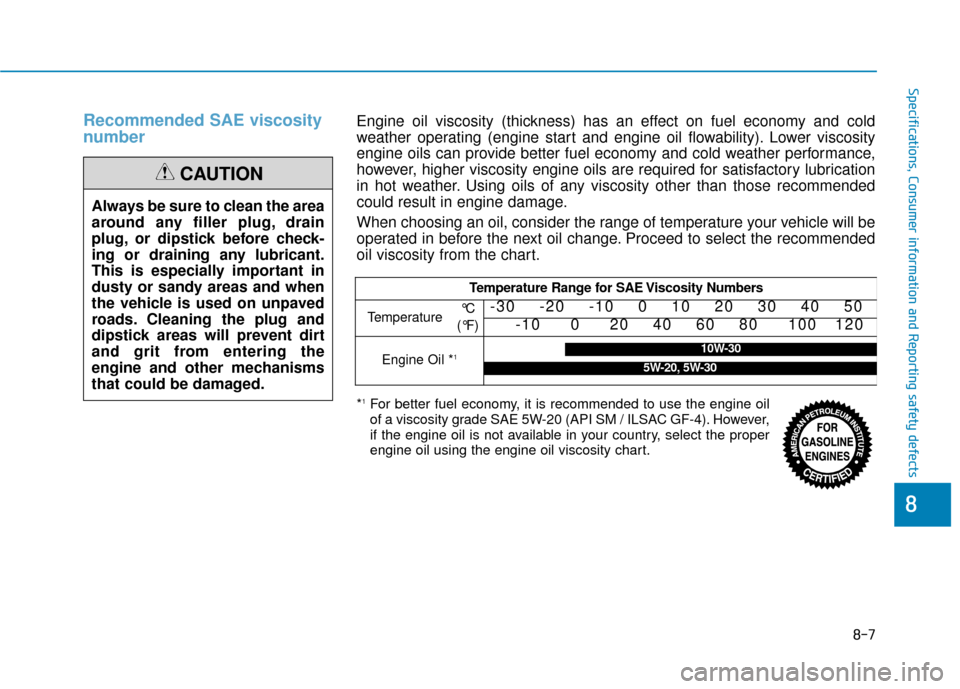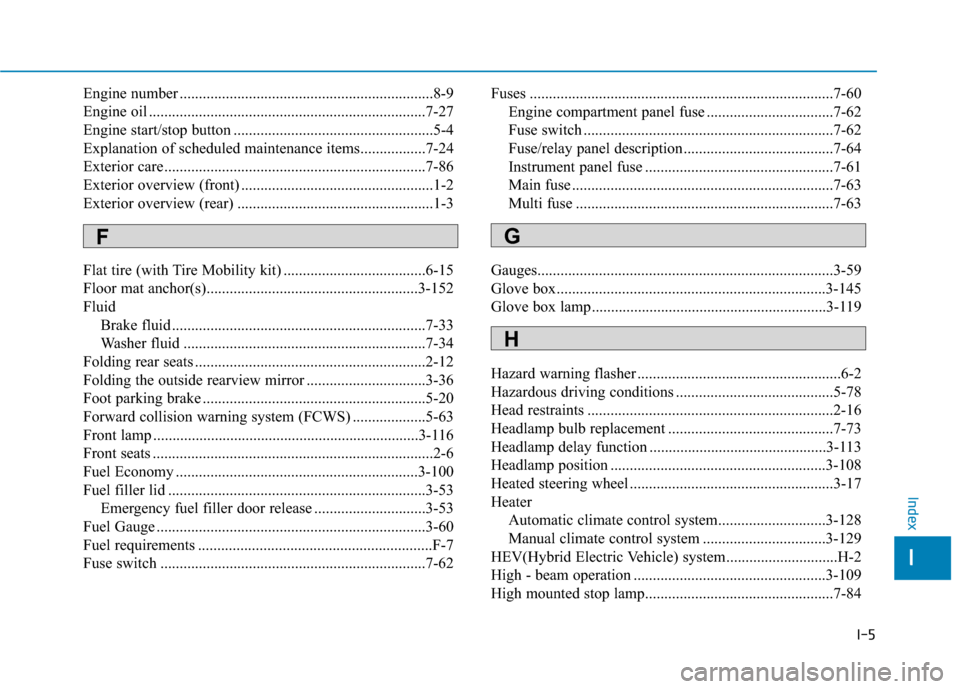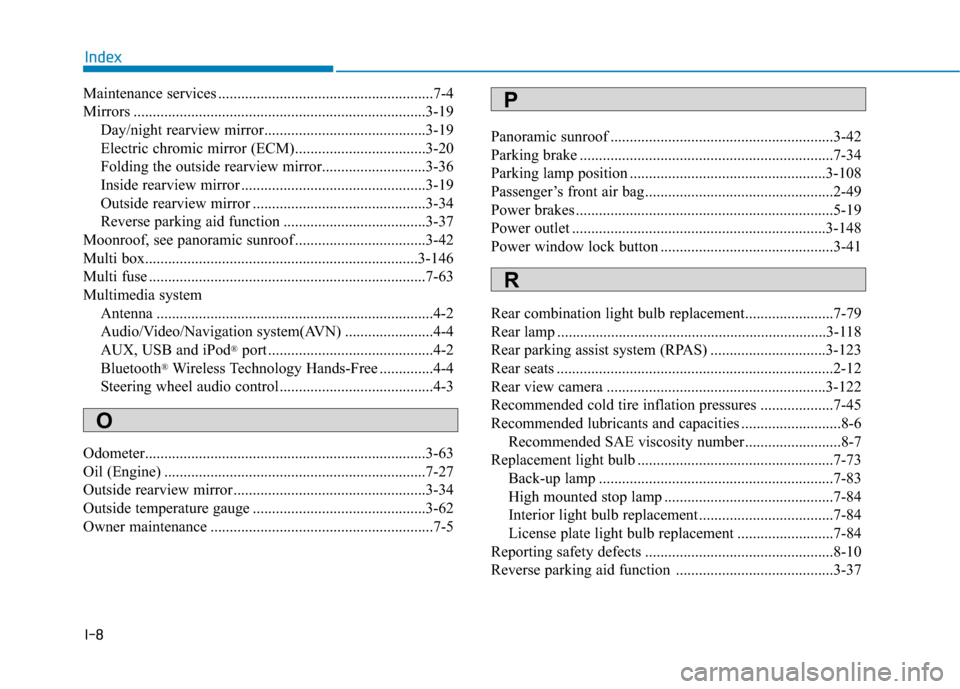2016 Hyundai Sonata Hybrid oil
[x] Cancel search: oilPage 637 of 708

7-73
7
Maintenance
Headlamp, position lamp,
turn signal lamp and side
marker light bulb replacement
Type A
(1) Headlamp (Low)
(2) Headlamp (High)
(3) Side marker
(4) Turn signal lamp
(5) Daytime running lamp/ Position lamp
Headlamp (Halogen bulb)
Always handle them carefully, andavoid scratches and abrasions. If
the bulbs are lit, avoid contact with
liquids.
Never touch the glass with bare hands. Residual oil may cause the
bulb to overheat and burst when lit.
A bulb should be operated only when installed in a headlamp.
If a bulb becomes damaged or cracked, replace it immediately
and carefully dispose of it.
OLFH074018L
OLMB073042L
Handle halogen bulbs with
care. Halogen bulbs contain
pressurized gas that will pro-
duce flying pieces of glass
that could cause injuries if
broken.
Wear eye protection when
changing a bulb. Allow the
bulb to cool down before han-
dling it.
WARNING
Page 651 of 708

7-87
7
Maintenance
Waxing
A good coat of wax is a barrier
between your paint and contaminate.
Keeping a good coat of wax on your
vehicle will help protect it.
Wax the vehicle when water will no
longer bead on the paint.
Always wash and dry the vehicle
before waxing. Use a good quality
liquid or paste wax, and follow the
manufacturer’s instructions. Wax all
metal trim to protect it and to main-
tain its luster.
Removing oil, tar, and similar materi-
als with a spot remover will usually
strip the wax from the finish. Be sure
to re-wax these areas even if the rest
of the vehicle does not yet need wax-
ing.
OLMB073082
Water washing in the engine
compartment including high
pressure water washing may
cause the failure of electrical
circuits located in the engine
compartment.
Never allow water or other liq-
uids to come in contact with
electrical/electronic compo-
nents inside the vehicle as
this may damage them.
CAUTION
Wiping dust or dirt off the
body with a dry cloth will
scratch the finish.
Do not use steel wool, abra-
sive cleaners, or strong deter-
gents containing highly alka-
line or caustic agents on
chrome-plated or anodized
aluminum parts. This may
result in damage to the pro-
tective coating and cause dis-
coloration or paint deteriora-
tion.
CAUTION
Page 655 of 708

7-91
7
Maintenance
vehicle, pay particular attention to
the components under the fenders
and other areas that are hidden
from view. Do a thorough job; just
dampening the accumulated mud
rather than washing it away will
accelerate corrosion rather than
prevent it. Water under high pres-
sure and steam are particularly
effective in removing accumulated
mud and corrosive materials.
When cleaning lower door panels, rocker panels and frame members,
be sure that drain holes are kept
open so that moisture can escape
and not be trapped inside to accel-
erate corrosion.Keep your garage dry
Don’t park your car in a damp, poor-
ly ventilated garage. This creates a
favorable environment for corrosion.
This is particularly true if you wash
your vehicle in the garage or drive it
into the garage when it is still wet or
covered with snow, ice or mud. Even
a heated garage can contribute to
corrosion unless it is well ventilated
so moisture is dispersed.
Keep paint and trim in good condition
Scratches or chips in the finish
should be covered with "touch-up"
paint as soon as possible to reduce
the possibility of corrosion. If bare
metal is showing through, the atten-
tion of a qualified body and paint
shop is recommended.
Bird droppings are highly corrosive
and may damage painted surfaces in
just a few hours. Always remove bird
droppings as soon as possible.
Interior care
Interior general precautions
Prevent caustic solutions such as
perfume and cosmetic oil, from con-
tacting the interior parts because
they may cause damage or discol-
oration. If they do contact the interior
parts, wipe them off immediately.
See the instructions for the proper
way to clean vinyl.
Never allow water or other liq-
uids to come in contact with
electrical/electronic compo-
nents inside the vehicle as
this may damage them.
When cleaning leather prod-
ucts (steering wheel, seats
etc.), use neutral detergents
or low alcohol content solu-
tions. If you use high alcohol
content solutions or acid/
alkaline detergents, the color
of the leather may fade or the
surface may get stripped off.
CAUTION
Page 656 of 708

7-92
Maintenance
Cleaning the upholstery andinterior trim
Vinyl
Remove dust and loose dirt from
vinyl with a whisk broom or vacuum
cleaner. Clean vinyl surfaces with a
vinyl cleaner.
Fabric
Remove dust and loose dirt from fab-
ric with a whisk broom or vacuum
cleaner. Clean with a mild soap solu-
tion recommended for upholstery or
carpets. Remove fresh spots imme-
diately with a fabric spot cleaner. If
fresh spots do not receive immediate
attention, the fabric can be stained
and its color can be affected. Also, its
fire-resistant properties can be
reduced if the material is not proper-
ly maintained.
Cleaning the seat belt webbing
Clean the belt webbing with any mild
soap solution recommended for
cleaning upholstery or carpet. Follow
the instructions provided with the
soap. Do not bleach or re-dye the
webbing because this may weaken
the seat belt.
Cleaning the interior windowglass
If the interior glass surfaces of the
vehicle become fogged (that is, cov-
ered with an oily, greasy or waxy
film), they should be cleaned with
glass cleaner. Follow the directions
on the glass cleaner container.
Using anything but recom-
mended cleaners and proce-
dures may affect the fabric’s
appearance and fire-resistant
properties.
CAUTION
Do not scrape or scratch the
inside of the rear window. This
may result in damage to the rear
window defroster grid.
CAUTION
Page 667 of 708

8-6
Specifications, Consumer information and Reporting safety defects
To help achieve proper engine and powertrain performance and durability, use only lubricants of the proper quality.
The correct lubricants also help promote engine efficiency that results in improved fuel economy.
R R E
EC
CO
O M
M M
ME
EN
N D
DE
ED
D
L
L U
U B
BR
RI
IC
C A
A N
N T
TS
S
A
A N
N D
D
C
C A
A P
PA
A C
CI
IT
T I
IE
E S
S
*1Refer to the recommended SAE viscosity numbers on the next page.
*2Engine oils labeled Energy Conserving Oil are now available. Along with other additional benefits, they contribute to fuel econo my by reducing
the amount of fuel necessary to overcome engine friction. Often, these improvements are difficult to measure in everyday driving, but in a year’s
time, they can offer significant cost and energy savings.
*
3If the API service SM engine oil is not available in your country, you are able to use API service SL.
LubricantVolume Classification
Engine oil *
1*2(drain and refill)
Recommends
4.33 US qt. (4.1 l)
API Service SM or above*3/ILSAC GF-4 or above
Automatic transaxle fluid
6.34 US qt. (6.0 l)MICHANG ATF SP-IV, SK ATF SP-IV NOCA ATF SP-IV,
HYUNDAI genuine ATF & SP-IV or other brands meeting the above specification approved by Hyundai Motor Co.
Engine coolant6.97~7.29 US qt.(6.6 ~ 6.9 l)Mixture of antifreeze and water
(Phosphate-based ethylene glycol coolant for aluminum radiator)
Inverter coolant
2.38 US qt. (2.26 l) Mixture of antifreeze and water
(Phosphate-based ethylene glycol coolant for aluminum radiator)
Brake fluid
0.74~0.85 US qt. (0.7~0.8 l) FMVSS116 DOT-3 or DOT-4
Fuel15.85 US gal. (60 l)Refer to “Fuel Requirements” in the Foreword chapter.
Page 668 of 708

8-7
88
Specifications, Consumer information and Reporting safety defects
Recommended SAE viscosity
number
Always be sure to clean the area
around any filler plug, drain
plug, or dipstick before check-
ing or draining any lubricant.
This is especially important in
dusty or sandy areas and when
the vehicle is used on unpaved
roads. Cleaning the plug and
dipstick areas will prevent dirt
and grit from entering the
engine and other mechanisms
that could be damaged.
CAUTION
Engine oil viscosity (thickness) has an effect on fuel economy and cold
weather operating (engine start and engine oil flowability). Lower viscosity
engine oils can provide better fuel economy and cold weather performance,
however, higher viscosity engine oils are required for satisfactory lubrication
in hot weather. Using oils of any viscosity other than those recommended
could result in engine damage.
When choosing an oil, consider the range of temperature your vehicle will be
operated in before the next oil change. Proceed to select the recommended
oil viscosity from the chart.
Temperature Range for SAE Viscosity Numbers
Temperature -30 -20 -10 0 10 20 30 40 50
-10 0 20 40 60 80 100 120
Engine Oil *110W-30
5W-20, 5W-30
°C
(°F)
*1For better fuel economy, it is recommended to use the engine oil
of a viscosity grade SAE 5W-20 (API SM / ILSAC GF-4). However,
if the engine oil is not available in your country, select the proper
engine oil using the engine oil viscosity chart.
Page 677 of 708

I-5
Engine number ..................................................................8-9
Engine oil ........................................................................\
7-27
Engine start/stop button ....................................................5-4
Explanation of scheduled maintenance items.................7-24
Exterior care....................................................................7-86\
Exterior overview (front) ..................................................1-2
Exterior overview (rear) ...................................................1-3
Flat tire (with Tire Mobility kit) .....................................6-15
Floor mat anchor(s).......................................................3-152
FluidBrake fluid ..................................................................7-33
Washer fluid ...............................................................7-34
Folding rear seats ............................................................2-12
Folding the outside rearview mirror ...............................3-36
Foot parking brake ..........................................................5-20
Forward collision warning system (FCWS) ...................5-63
Front lamp .....................................................................3-1\
16
Front seats ........................................................................\
.2-6
Fuel Economy ...............................................................3-100
Fuel filler lid ...................................................................3-53 Emergency fuel filler door release .............................3-53
Fuel Gauge ......................................................................3-\
60
Fuel requirements .............................................................F-7
Fuse switch .....................................................................7-6\
2 Fuses ........................................................................\
.......7-60
Engine compartment panel fuse .................................7-62
Fuse switch .................................................................7-62
Fuse/relay panel description .......................................7-64
Instrument panel fuse .................................................7-61
Main fuse ....................................................................7-63\
Multi fuse ...................................................................7-63
Gauges........................................................................\
.....3-59
Glove box......................................................................3-\
145
Glove box lamp .............................................................3-119
Hazard warning flasher .....................................................6-2
Hazardous driving conditions .........................................5-78
Head restraints ................................................................2-16
Headlamp bulb replacement ...........................................7-73
Headlamp delay function ..............................................3-113
Headlamp position ........................................................3-108
Heated steering wheel .....................................................3-17
Heater Automatic climate control system............................3-128
Manual climate control system ................................3-129
HEV(Hybrid Electric Vehicle) system.............................H-2
High - beam operation ..................................................3-109
High mounted stop lamp.................................................7-84
I
Index
FG
H
Page 680 of 708

I-8
Maintenance services ........................................................7-4
Mirrors ........................................................................\
....3-19Day/night rearview mirror..........................................3-19
Electric chromic mirror (ECM)..................................3-20
Folding the outside rearview mirror...........................3-36
Inside rearview mirror ................................................3-19
Outside rearview mirror .............................................3-34
Reverse parking aid function .....................................3-37
Moonroof, see panoramic sunroof ..................................3-42
Multi box.......................................................................3\
-146
Multi fuse ........................................................................\
7-63
Multimedia system Antenna ........................................................................\
4-2
Audio/Video/Navigation system(AVN) .......................4-4
AUX, USB and iPod
®port ...........................................4-2
Bluetooth®Wireless Technology Hands-Free ..............4-4
Steering wheel audio control........................................4-3
Odometer........................................................................\
.3-63
Oil (Engine) ....................................................................7-27\
Outside rearview mirror..................................................3-34
Outside temperature gauge .............................................3-62
Owner maintenance ..........................................................7-5 Panoramic sunroof ..........................................................3-42
Parking brake ..................................................................7-34
Parking lamp position ...................................................3-108
Passenger’s front air bag.................................................2-49
Power brakes ...................................................................5-19
Power outlet ..................................................................3-148
Power window lock button .............................................3-41
Rear combination light bulb replacement.......................7-79
Rear lamp ......................................................................3-\
118
Rear parking assist system (RPAS) ..............................3-123
Rear seats ........................................................................\
2-12
Rear view camera .........................................................3-122
Recommended cold tire inflation pressures ...................7-45
Recommended lubricants and capacities ..........................8-6
Recommended SAE viscosity number .........................8-7
Replacement light bulb ...................................................7-73 Back-up lamp .............................................................7-83
High mounted stop lamp ............................................7-84
Interior light bulb replacement ...................................7-84
License plate light bulb replacement .........................7-84
Reporting safety defects .................................................8-10
Reverse parking aid function .........................................3-37
Index
O
P
R